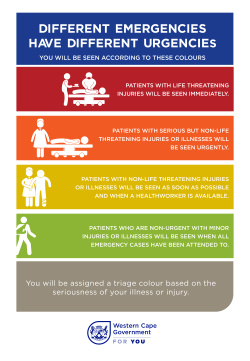Emergency Medical Care
 Visiting the Emergency Centre (EC) can be very stressful to help you understand this environment, please have a look at these Frequently Asked Questions.
Visiting the Emergency Centre (EC) can be very stressful to help you understand this environment, please have a look at these Frequently Asked Questions.
How are patients prioritised?
This is a 24-hour EC. Staff focus on assisting patients who are in life-or-death situations. Many patients arrive at the Emergency Unit, so, to determine who must be helped first, our staff look at:
- How sick you are when you arrive (e.g. Are you walking/talking vs are you being carried in and struggling to breathe
- The information you give staff about your health concern (e.g. at a glance you may seem okay, but if you suddenly experienced weakness on one side of your body, you
maybe experiencing a stroke, which requires urgent help) - What your vital signs (e.g. blood pressure, pulse) indicate
According to this initial assessment of your health (triage) you are given a colour code that tells other healthcare staff how urgently you need assistance.
If you are triaged as green and do not have an emergency, you may be asked to visit your clinic, day hospital or general practitioner for assistance or to return to the hospital for an appointment as an outpatient.
If I have a referral letter, will I be seen as an urgent patient?
If you arrive with a referral letter by the local day hospital, GP, or any other person, you too will have to be triaged to determine how urgent healthcare workers should assist you. Your urgency is determined by the above-mentioned factors when you arrive.
If you were referred to the EC for a scan or specific test, you will first be assessed before doctors will determine whether the test will be administered and the date it will be done.
Why are there such long waiting periods in the EC?
Keep in mind that there is more than one waiting area in the EC, and there is a separate ambulance entrance at the back of EC. This means that at a glance you are not seeing all the patients who came to the EC for help. You may experience a longer waiting time when we are tending to patients who are brought in by ambulance. If they are triaged red, they will receive immediate help. However, if you start to feel worse while you are waiting your turn, please tell a healthcare worker immediately.
As a family member, how will I be kept informed?
Our EC is very busy, so when attending to adult patients that are coherent and able to communicate, we will communicate with the patient directly.
If the patient has a cellphone, we encourage them to contact close relatives. If not, they can use a phone at the hospital.
We realise that family members are concerned, so we also make an effort to keep you informed by talking to you in the waiting area or calling you. We may also need more information about the patient, so may reach out to you for this.
It is very important that we have your contact details on the file. Please make sure your number is given accurately and that your cellphone is working. Save the hospital’s number on your phone so you can quickly see if we reached out to you.
Should I stay in the waiting area while you are taking care of the patient?
You can choose if you want to stay at the hospital or go home while waiting for family member who is being treated at the EC. The EC is usually very busy, so it may be more comfortable for you to wait at home.
Depending on how busy it is at any point in the EC, there may be limited seating available. As far as possible, only one person should accompany a patient.
May I go into the Emergency Centre?
The security guards have been instructed to only let people into the unit who have been called. Please cooperate with staff.
Although there are no visiting hours in the emergency unit, families are allowed to greet patients or drop-off essential items off for them.
We understand that it can be very distressing to know a family member is receiving emergency care, but please don’t flag down staff to ask for updates. Only staff assisting your loved one will have the information. The relevant doctor attending to the patient will contact the family as explained above. If the patient is admitted to the hospital, you can visit them during visiting hours.
If I am a patient, can I leave after being triaged?
If you came to the EC and you feel better, decide to go home or seek assistance elsewhere you are welcome to do so. Before you leave, please inform a healthcare worker. If you return, we will assist you.
I don’t have an emergency, but I want to see the doctor.
If you came to the EC, think you do not have an EMERGENCY but still wish to see a doctor here, you are welcome to stay. Please, however, make sure you are aware that you may wait a long time. Sometimes -non-urgent patients could wait a very long time.
Here's more information on who to call in an emergency.
Watch this video to learn all you need to know about visiting the Emergency Centre:


